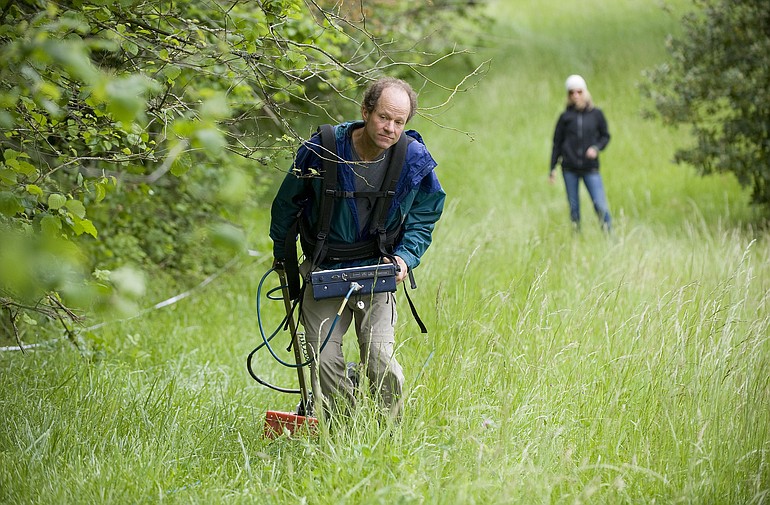Do you know any details about the former Clark County poor farm or the people who lived there?
Contact Jacqui Kamp in Clark County Community Planning at
360-397-2280
ext. 4913 or jacqueline.kamp@clark.wa.gov.
The pine boxes, lowered into the ground so many decades ago, have decomposed.
So have the bodies.
The grave markers are long gone, too.
But as the county moves forward with plans for the newly titled 78th Street Heritage Farm, it’s important to figure out exactly where the bodies were buried in the county poor farm’s cemetery, which runs along the western edge of the 79-acre site in Hazel Dell.
On Tuesday, three employees of SWCA, a Portland-based environmental consulting firm, were working on determining the cemetery boundaries by trying to locate all the burial plots using ground-penetrating radar.
An estimated 200 people were buried there from approximately 1913 to 1937.
“If they were metal caskets, this would be a piece of cake,” said Blake Weissling, a San Antonio-based geophysicist for SWCA.
He was wearing a harness that cradled the console of his SIR-3000 and pulling the red device, which was attached to a surveyor’s wheel, through knee-high weeds.
He stopped when his machine detected an anomaly beneath the ground, indicating a grave site.
Weissling said once he’s through using the radar he had two other methods, magnetometry and electrical conductivity, to use in order to try and detect all the plots. All three methods work differently, but between identifying earth that had been disturbed and detecting leftover items such as belt buckles and coffin nails, he hoped to get a complete layout of the cemetery.
Selena Roloson, an archaeologist, said the technologies were ideal for the project.
“We’re not disturbing the surface,” she said.
Jason Allen, a historic preservation specialist, said a 1913 plat of the cemetery shows it as 150 feet wide and 300 feet long. Those dimensions go beyond a fence currently separating the cemetery from the rest of the site.
A minimal survey conducted in 2004 didn’t define the cemetery’s boundaries, said Jacqui Kamp of Clark County’s Community Planning department.
Kamp said the county received a Certified Local Government Historic Preservation Fund grant of $11,500 from the Washington Department of Archaeology and Historic Preservation to survey and record the cemetery and the poor farm’s main building and outbuildings.
In April, the Board of County Commissioners approved plans for the Heritage Farm project. The county had already lined up money from the 2009 federal stimulus bill to improve heating, cooling and electrical systems in the main building on the site, which once housed agricultural research for the local Washington State University Extension office.
Elements of the plan include a trail system with viewpoints and signs, energy-efficient greenhouses, continued community and food bank gardens and a parking area that might host a farmers market.
What commissioners don’t want are trails over the grave sites.
Instead, there could be a viewpoint at the top of the hillside with information about the cemetery, Kamp said.
While there’s no official recording of who was buried where, several years ago local genealogists Mary Snell, Kitty Oman and Rose Marie Harshman did research, including reading old newspaper obituaries, and compiled a list of people buried in the cemetery. Harshman told some of the people’s stories in “The County Farm Cemetery Book.”
The people buried in the cemetery include not just the older people who lived at the poor farm, but younger people who worked the fields. Or anyone, Allen said, who died destitute.
In 1966, Clark County commissioners honored all of the people buried at the poor farm with a plaque bearing the words:



